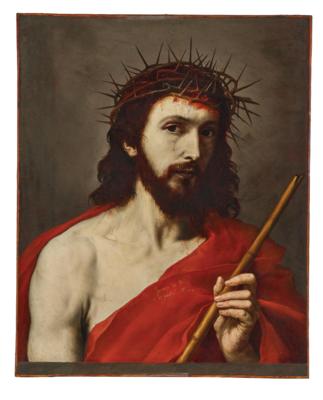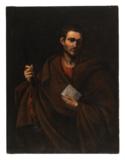Jusepe de Ribera, called Lo Spagnoletto
(Xàtiva 1591–1652 Naples)
Ecce Homo,
signed and dated: Jusepe de Ribera / español ,F. 1644,
oil on canvas, 70 x 57 cm, framed
Provenance:
sale, Christie, Manson & Woods, 17 March 1888, lot 83 (as Jusepe de Ribera);
Obdulio Moncada Calderón Collection, Cartagena, 1890 until at least 1907;
possibly by descent in the family;
Private collection, London, until 2022
Literature:
M. González Simancas, Catálogo Monumental de España. Provincia de Murcia 1905–1907, Manuscript, digitalised by CSIC Tomás Navarro Tomás Library, vol. II, pp. 334–335 (as Jusepe de Ribera)
This outstanding signed and dated Ecce Homo was first published by Manuel González Simancas (1855–1942) a member of the Real Academia de Bellas Artes de San Fernando from Córdoba. He cites the painting in his manuscript (see literature) as follows:
‘827. – Mr Obdulio Moncada, whom I have already mentioned, owns a good canvas by Lo Spagnoletto (photo 199), representing Ecce Homo with his right shoulder and part of his chest uncovered, holding the reed in his left hand. This painting could be included among the best works of that brilliant artist, and his signature appears on the red cloth covering the other half of the chest and the left shoulder. Jusepe de Ribera // español (Spaniard), F.1644. The painting, without its frame, is 68 cm high and 55 cm wide, and it is in a very good state of conservation’.
According to the manuscript this painting belonged to the collection of Obdulio Moncada Calderón, who was mayor of Cartagena and president of the local press association, as well as editor of the newspaper Eco de Cartagena in the late 19th century.
The present work belongs to the artist’s full maturity, and was produced when he was convalescing after an illness that had delayed many of his commissions. Ribera’s naturalism, revealed his early paintings in Rome, continued throughout his long artistic career. His painterly style displays a masterful use of light and shadow, using a limited colour palette, creating an incredible sense of immediacy. This is further enhanced in the present composition by the depiction of Christ, close-up with direct eye contact with the viewer. The format and size of this Ecce Homo was common in the production of the painter, as evidenced in some paintings from his series of apostles or philosophers.
The subject of the Ecce Homo was popular during the Counter-Reformation and Ribera executed several versions, including one conserved at the Real Academia de Bellas Artes de San Fernando in Madrid (inv. no. 0629), signed with legated initials ‘J’ and ‘R’. Further comparable paintings from his mature period are the Ecce Homo at the Ateneum Museum in Helsinki (inv. no. A II 1361), the Ecce Homo in the Hermitage Museum in Saint Petersburg (inv. no. ГЭ-7760) and another in the Bob Jones University Collection of Sacred Art, Greenville.
Jusepe de Ribera was born in Spain and travelled to Italy as a young man. In Rome from about 1613 to 1616, he developed a personal style that was significantly influenced by the work of Caravaggio. During the 1630s he encountered the work of Anthony van Dyck and Guido Reni, while he perfected his naturalistic style following Diego Velazquez in Naples.
By the 1640s Ribera’s career was already well established in Naples and created dramatic works during this period, articulated through contrasts of light and shade. Ribera was aware of Caravaggio’s technique of painting and experimented with chiaroscuro, though he never became a direct follower of Caravaggio and developed his own singular style of painting. The present painting is an exceptional example of his work.
Specialist: Mark MacDonnell
 Mark MacDonnell
Mark MacDonnell
+43 1 515 60 403
mark.macdonnell@dorotheum.at
25.10.2023 - 18:00
- Estimate:
-
EUR 800,000.- to EUR 1,200,000.-
Follow Remove
Jusepe de Ribera, called Lo Spagnoletto
(Xàtiva 1591–1652 Naples)
Ecce Homo,
signed and dated: Jusepe de Ribera / español ,F. 1644,
oil on canvas, 70 x 57 cm, framed
Provenance:
sale, Christie, Manson & Woods, 17 March 1888, lot 83 (as Jusepe de Ribera);
Obdulio Moncada Calderón Collection, Cartagena, 1890 until at least 1907;
possibly by descent in the family;
Private collection, London, until 2022
Literature:
M. González Simancas, Catálogo Monumental de España. Provincia de Murcia 1905–1907, Manuscript, digitalised by CSIC Tomás Navarro Tomás Library, vol. II, pp. 334–335 (as Jusepe de Ribera)
This outstanding signed and dated Ecce Homo was first published by Manuel González Simancas (1855–1942) a member of the Real Academia de Bellas Artes de San Fernando from Córdoba. He cites the painting in his manuscript (see literature) as follows:
‘827. – Mr Obdulio Moncada, whom I have already mentioned, owns a good canvas by Lo Spagnoletto (photo 199), representing Ecce Homo with his right shoulder and part of his chest uncovered, holding the reed in his left hand. This painting could be included among the best works of that brilliant artist, and his signature appears on the red cloth covering the other half of the chest and the left shoulder. Jusepe de Ribera // español (Spaniard), F.1644. The painting, without its frame, is 68 cm high and 55 cm wide, and it is in a very good state of conservation’.
According to the manuscript this painting belonged to the collection of Obdulio Moncada Calderón, who was mayor of Cartagena and president of the local press association, as well as editor of the newspaper Eco de Cartagena in the late 19th century.
The present work belongs to the artist’s full maturity, and was produced when he was convalescing after an illness that had delayed many of his commissions. Ribera’s naturalism, revealed his early paintings in Rome, continued throughout his long artistic career. His painterly style displays a masterful use of light and shadow, using a limited colour palette, creating an incredible sense of immediacy. This is further enhanced in the present composition by the depiction of Christ, close-up with direct eye contact with the viewer. The format and size of this Ecce Homo was common in the production of the painter, as evidenced in some paintings from his series of apostles or philosophers.
The subject of the Ecce Homo was popular during the Counter-Reformation and Ribera executed several versions, including one conserved at the Real Academia de Bellas Artes de San Fernando in Madrid (inv. no. 0629), signed with legated initials ‘J’ and ‘R’. Further comparable paintings from his mature period are the Ecce Homo at the Ateneum Museum in Helsinki (inv. no. A II 1361), the Ecce Homo in the Hermitage Museum in Saint Petersburg (inv. no. ГЭ-7760) and another in the Bob Jones University Collection of Sacred Art, Greenville.
Jusepe de Ribera was born in Spain and travelled to Italy as a young man. In Rome from about 1613 to 1616, he developed a personal style that was significantly influenced by the work of Caravaggio. During the 1630s he encountered the work of Anthony van Dyck and Guido Reni, while he perfected his naturalistic style following Diego Velazquez in Naples.
By the 1640s Ribera’s career was already well established in Naples and created dramatic works during this period, articulated through contrasts of light and shade. Ribera was aware of Caravaggio’s technique of painting and experimented with chiaroscuro, though he never became a direct follower of Caravaggio and developed his own singular style of painting. The present painting is an exceptional example of his work.
Specialist: Mark MacDonnell
 Mark MacDonnell
Mark MacDonnell
+43 1 515 60 403
mark.macdonnell@dorotheum.at
|
Buyers hotline
Mon.-Fri.: 10.00am - 5.00pm
old.masters@dorotheum.at +43 1 515 60 403 |
| Auction: | Old Masters |
| Auction type: | Saleroom auction with Live Bidding |
| Date: | 25.10.2023 - 18:00 |
| Location: | Vienna | Palais Dorotheum |
| Exhibition: | 14.10. - 25.10.2023 |


